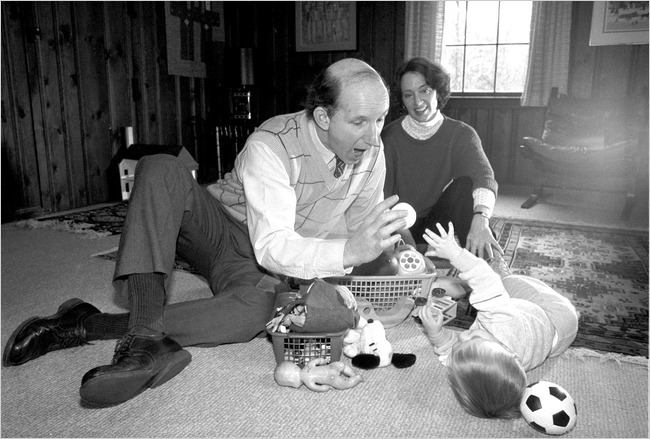How Infants Learn Language: Dr. Greenspan Was Right 40 Years Ago!
(Stanley I Greenspan MD Inc. and its intervention, The Greenspan Floortime Approach®, DO NOT endorse or support ICDL or its DIRFloortime curriculum)
Learning a language is one of the most complex and impressive feats that humans accomplish. But how do we go from crying babies to fluent speakers in just a few short years? The answer lies in the intricate workings of the infant brain and the power of human interaction.
Dr. Greenspan, renowned for his Greenspan/DIR Model (introduced in the late 1970’s) and his leadership as the founding president of the Zero to Three Foundation in 1978, has long emphasized the importance of interactive experiences in shaping a child’s brain. Research from MIT provides compelling evidence for the critical role of interaction in early language development, validating the pioneering work of Dr. Stanley Greenspan. Having real back-and-forth interactions (proto-conversations) with your little one is even more crucial for their language development than just focusing on how many words they hear (https://pubmed.ncbi.nlm.nih.gov/29442613/). The implications of this research are significant, underscoring the need for caregivers and educators to prioritize meaningful interactions and responsive communication with young children. By fostering these dynamic exchanges, and not simply passively listening to words from people or devices, we can optimize language development and lay a strong foundation for neurological, social-emotional, and cognitive health.
The Science of Sound and Interaction to Language
The remarkable journey infants take in learning a language, starts with the perception of sounds, where babies’ brains are incredibly active in distinguishing between different phonetic sounds. This ability is honed by exposure to “parentese,” the sing-songy way adults naturally speak to babies, which helps them segment words and phrases. Simultaneously, infants are learning the art of ‘conversation’, or proto-conversations. Back-and-forth interactions, even before they can speak, stimulate crucial brain development in areas associated with language processing and social patterns. These early exchanges lay the groundwork for understanding the give-and-take of communication and its intent and purpose within social exchanges.
Perhaps most importantly, the richness of interaction and language exposure shapes the very structure of the infant brain. Early exposure to a diverse vocabulary within these back-and-forth interactions influences the development of critical brain structures associated with reading and language skills.
The Greenspan Floortime Approach®
The Greenspan Floortime Approach® is a child-centered, interaction-based therapy that focuses on building the foundational Milestones necessary for social-emotional growth and learning. The approach emphasizes the importance of following the child’s lead, creating a developmentally supportive play-based environment, and fostering warm and engaging interactions.
In the context of language development, The Greenspan Floortime Approach® encourages parents and therapists to become active play partners, following the child’s interests and engaging in back-and-forth interactions while talking ‘with’ them. In his Greenspan/DIR™ Model, Dr. Greenspan’s validated model of child development that Floortime is based on, he described the developmental stages children progress through while mastering these types of social interactions. Starting by mimicking simple facial expressions as responses within the first few weeks of life, babies graduate to consistently responding to and initiating within caregiver interactions by 9 months (Greenspan/DIR™ Milestone 3). By 18 months a child should be able to consistently engage in a 20-30 step back and forth interaction. This capacity is known as ‘The Continuous Flow of Interaction’ (Greenspan/DIR™ Milestone 4). This Continuous Flow, called Proto-Conversations by neuroscientists, is a neurological and developmental prerequisite to robust conversational language development. This approach aligns seamlessly with the research on how infants translate sounds to language though back and forth interactions, providing a framework for creating an interaction-rich environment that supports optimal language development.
It’s important to remember that every child develops at their own pace. If you notice your child isn’t reaching social-emotional milestones as quickly as others their age, don’t worry! You can make a real difference by being more intentional about how you and others interact with them. Children who take a little longer in this area often experience the world in unique ways (sensory and/or emotional processing differences), making it harder for them to learn from everyday interactions. The good news is that by adjusting their environment and how you engage with them, you can unlock their full potential. Think of it as creating a sensorily and emotionally supportive space where they feel safe and comfortable, allowing them to truly thrive. Greenspan Floortime® offers valuable techniques to help you connect and interact with your child in a way that honors their individual needs and celebrates their strengths. EVERY child has the potential to enjoy and benefit from these nurturing and interactive experiences, and it’s never too early or too late to begin prioritizing them.
Key takeaways for parents and caregivers:
- DO NOT simply rely on talking to or around a child, reading books to them, or on digital devices to expose them to words and ideas.
- Engage in back-and-forth interactions, even before your baby can speak.
- Additional research shows that Caregiver Responsiveness Matters for both language and cognitive development.
- Talk to your baby frequently, using parentese within these back-and-forth interactions.
- Expose your baby to a rich and varied vocabulary as it applies to elements of your interactions.
- Create a warm and developmentally supportive environment where your baby feels safe to explore and learn.
- Incorporate the principles of the Greenspan Floortime Approach® to create a shared world and playfully interact to foster your baby’s social-emotional and language development.
- Some children are very sensitive and may become avoidant, self-involved, or reactive when we try to play and interact with them. Applying Greenspan Floortime techniques may be necessary to help work through these challenging moments in a manner that acknowledges the child’s individual differences.
By understanding the science of child development and behind language acquisition, and embracing strategies that support this process, we can empower all infants to reach their full potential.
butions of every individual while providing developmentally appropriate environments that encourage growth.


Unlock the secrets of Dr. Greenspan’s Floortime: Learn to APPLY Greenspan Floortime. Purchase the comprehensive Floortime Manual 2nd Edition and embark on a journey of joyful, meaningful communication with your child


Earn a Greenspan Floortime Certificate: Take your expertise to the next level and earn an official Greenspan Floortime Certificate, recognized worldwide.


Please contact us with any questions or requests, info@stanleygreenspan.com